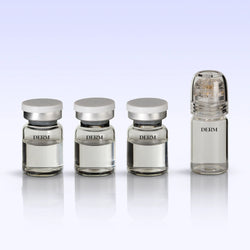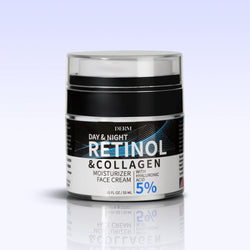Beyond Wrinkles: Understanding and Treating Crepey Skin

Written by Our Editorial Team
6 MINUTES READ
If you've noticed your skin starting to resemble crepe paper, thin, delicate, and finely wrinkled… you're not alone.
While wrinkles might get all the attention in anti-aging conversations, crepey skin is equally common yet often misunderstood.
Unlike typical wrinkles that form from repeated facial expressions, crepey skin affects larger areas and has a distinctly different texture.
So what exactly causes this tissue-paper appearance, and more importantly, what can be done about it?
Let's dive into understanding crepey skin and discover the most effective ways to address it.

What Is Crepey Skin (And How Is It Different From Regular Wrinkles)?
Crepey skin is characterized by its thin, fragile appearance that resembles crepe paper.
While wrinkles typically form as distinct lines in areas of repeated movement (like smile lines or forehead creases), crepey skin covers broader patches and has a crinkled, paper-thin quality.
The most common areas to develop crepiness include:
- Under the eyes
- Upper inner arms
- Décolletage (chest)
- Neck and jawline
- Back of hands
- Knees and elbows
Why Does Skin Turn Crepey?
Several factors contribute to the development of crepey skin:
1. Collagen and Elastin Breakdown
The foundation of firm, youthful skin lies in two critical proteins: collagen and elastin.
Collagen provides structure and firmness, while elastin gives skin its ability to stretch and bounce back.
As we age, our bodies naturally produce less of both these proteins.
Research shows that collagen production decreases by approximately 1% each year after age 20, with a more dramatic decline occurring for women after menopause.
2. Sun Damage
UV exposure is perhaps the most significant preventable cause of crepey skin.
Studies have found that up to 80% of visible facial aging comes from accumulated sun damage rather than chronological aging.
"UV rays penetrate deep into the dermis layer of skin, breaking down collagen and elastin fibers much faster than would happen naturally," notes dermatologist Dr. Whitney Bowe.
"This is why you'll often see crepiness first develop on sun-exposed areas like the chest and arms."
3. Dramatic Weight Changes
Rapidly losing or gaining significant weight can stretch skin beyond its ability to retract, particularly as we age and skin becomes less elastic.
This can leave behind that loose, crepey appearance even after weight stabilizes.
4. Dehydration and Dryness
When skin lacks proper hydration, it appears more crepey and pronounced.
This is particularly true as we age and our skin's natural moisturizing factors diminish.
5. Hormonal Changes
The hormonal shifts that occur during menopause significantly impact skin quality. Estrogen plays a key role in maintaining skin thickness, hydration, and elasticity, all of which decline as estrogen levels drop.
Effective Treatments for Crepey Skin
The good news? Crepey skin can be improved with the right approach.
Here are science-backed strategies to address this common concern:
1. Topical Treatments
Hyaluronic Acid: This powerful humectant attracts and holds up to 1,000 times its weight in water, providing immediate plumping and hydration to crepey areas. A concentrated formula like our 3% Hyaluronic Acid Serum delivers deeper hydration than standard 2% solutions, helping to visibly smooth crepey texture with consistent use.
Retinoids: Derivatives of vitamin A are clinically proven to stimulate collagen production and accelerate cell turnover. A study published in the Journal of Cosmetic Dermatology found that after 12 weeks of retinol application, participants showed significant improvement in skin firmness and reduction in crepey appearance.
Peptides: These amino acid chains act as messengers, signaling skin cells to produce more collagen. They're especially beneficial for delicate areas prone to crepiness, like around the eyes, where harsher ingredients might cause irritation.
2. Professional Treatments
For more advanced crepey skin concerns, in-office treatments can provide more dramatic results:
Microneedling: This procedure creates thousands of microscopic punctures in the skin, triggering the body's wound healing response and stimulating collagen production. A 2018 study found that patients undergoing microneedling treatments experienced a 45-55% improvement in skin texture after just three sessions.
Radiofrequency: Devices that deliver radiofrequency energy heat the deeper layers of skin, encouraging collagen remodeling while leaving the surface unharmed. Results typically develop gradually over 2-3 months as new collagen forms.
3. At-Home Devices
The technological revolution in skincare has made professional-grade treatments more accessible than ever:
Red Light Therapy: Using specific wavelengths of red light penetrates skin to stimulate cellular repair and increase collagen production. A 2014 study published in Photomedicine and Laser Surgery found that participants receiving red light therapy twice weekly for 30 days showed significant improvement in skin complexity and collagen density.
Micro-Infusion Systems: Home devices that create temporary microchannels in the skin can enhance the delivery and effectiveness of anti-aging ingredients by up to 300%. This allows products to penetrate beyond the skin's natural barrier, addressing crepiness at a deeper level.
4. Lifestyle Changes
Never underestimate the power of these fundamental habits:
Sun Protection: Daily, year-round SPF 30 or higher is non-negotiable for preventing further damage. Remember to extend protection to often-neglected areas like the neck, chest, and hands.
Hydration: Drinking adequate water supports skin's moisture balance from within, while using topical hydrating ingredients helps maintain the skin barrier.
Nutrition: A diet rich in antioxidants, healthy fats, and protein provides the building blocks for healthy skin. Foods high in vitamin C are particularly beneficial as this vitamin is essential for collagen synthesis.
The Multi-Faceted Approach to Treating Crepey Skin
For optimal results, experts recommend combining strategies rather than relying on a single treatment.
This multi-faceted approach typically includes:
- Daily Care: Using hydrating, collagen-stimulating products consistently
- Targeted Treatment: Addressing specific areas of concern with concentrated formulas
- Protection: Preventing further damage through sun protection and antioxidants
- Periodic Intervention: Incorporating professional treatments or advanced at-home devices
Experience the DERM™ Difference
While crepey skin is a natural part of aging, the right skincare strategy can make a remarkable difference in its appearance. Our 3% Hyaluronic Acid Serum delivers concentrated hydration to thirsty skin, helping to plump and smooth crepey areas for a more youthful appearance.
Meanwhile, our Micro Infusion System creates temporary microchannels that enhance product absorption by up to 300%, allowing anti-aging ingredients to penetrate deeper for more dramatic improvements in skin texture and firmness.
Remember, addressing crepey skin isn't about turning back the clock, it's about supporting your skin's natural health so you can feel confident at any age.
With consistent care and the right products, you can significantly improve crepey texture and enjoy firmer, more resilient skin for years to come.
What skin concerns are you looking to address? Share your experience!





